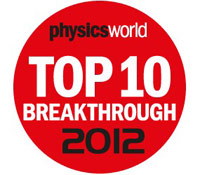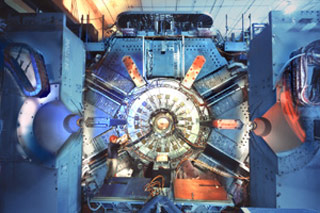Physicist tracks ‘the arrow of time’
Fri, 14 Dec 2012 14:11:00 GMT
University professor plays a role in one of the year’s major physics breakthroughs

A LEADING physicist based at the University of Huddersfield is a member of a global team whose research, leading to greater understanding of the nature of time, has been hailed as one of the key breakthroughs of the year.
Professor Roger Barlow (pictured) is a particle physicist and a member of the University of Huddersfield’s International Institute for Accelerator Applications. He has taken part in many important international research collaborations, including BaBar, a detector built at the USA’s SLAC National Accelerator Laboratory in California to study the collisions of electrons and positrons and determine the differences between matter and antimatter.
Physicists and engineers from 72 institutions in 12 countries have taken part in the analysis of data produced at BaBar.
Earlier this year it was revealed that the team had made the first direct observation of “time reversal violation”. This was reported in the journal Physical Review Letters.

Now Physics World, the leading magazine in its field, has named the BaBar findings as one of its Top Ten Breakthroughs of 2012. It joins a list of scientific achievements that include the discovery of a Higgs-like particle at CERN’s Large Hadron Collider.
The magazine’s judges reviewed 350 news articles describing advances in physical science during 2012 and concluded that the report on BaBar’s discovery – for which Professor Barlow was credited as one of the joint authors – deserved a place in the top ten because of the fundamental importance of its research and the extent to which it had made a significant advance in knowledge.
The research has led to fresh understanding of the “arrow of time”, a concept that has been described as “one of the great mysteries in elementary particle physics”.
Particles and anti-particles
Professor Barlow explained that the BaBar data enabled scientists to witness transformations between several different neutral particles known as B mesons, as they changed they changed into each other at different rates. It provided confirmation of a long-held theory and helped to show that there was an arrow of time at the fundamental microscopic level.
“We knew there was a difference between particles and anti-particles and we believed that if you have particles going forwards in time and anti-particles going backwards in time then that is in some sense the same thing. We knew the symmetry was broken in one area, so we could say that it had to be broken in the other.
“But this is the first time that this has definitely been seen and we have been able to say that this is a change in the direction of time and not the difference between particle and anti-particle.”
However, added Professor Barlow, the findings did not provide an answer to the fundamental issue of why the past was different to the future. “That remains a different set of questions,” he says.
Professor Barlow was involved with the BaBar project from its inception in the 1990s. He helped to produce some of the components and spent a sabbatical year at Stanford University, California, where the facility was based.
The BaBar particle detector was decommissioned in 2008, but the research goes on. “The experiment has stopped running, but it produced an enormous amount of really beautiful data which we are still analysing,” said Professor Barlow.
Click here to read Physics World Top 10 Breakthrough 2012

The BaBar detector - now decomissioned but leaving a vast legacy of data







